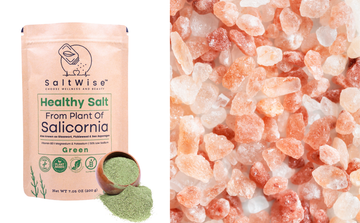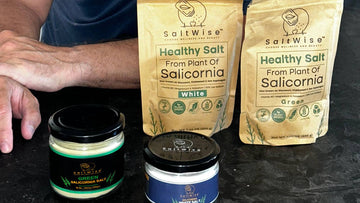
Food preservation is one of the innate aspects of human history. It has enabled and still empowers mankind to extend the shelf life of foods and ensure food’s authenticity. Among the oldest and most reliable methods of preservation is the use of salt. The components of salt (sodium chloride and other minerals) not only help to preserve our food but also enhance its flavor and nutritional value.
Throughout history, food preservation techniques have evolved in intriguing ways based on local customs and cultural norms in order to cope with the seasons of scarcity. To mention a few, there are the popular stinky cheeses of France, the tart sauerkraut of Germany (which actually came from China), the miso paste of Japan, the salted fish of Iceland, fermented Herring fish in the Netherlands and the cured meats of other nations. While some preservation techniques have welcomed microbial life to create many of the delicacies, we are familiar with today, others have worked to reduce the role of microbes in food by creating environments that are unfriendly to their settlement.
Today, in this blog, SaltWise will help you understand the magical science behind salt preservation, various foods that use salt with low sodium for preservation and the benefits of using Salicornia salts in food preservation.
Let’s begin!
Science Behind Salt Preservation
Osmosis is the main mechanism through which salt preservation science works with other foods. Salt induces a hypertonic environment that prevents microbial growth by sucking water out of microbial cells. The preserved food's shelf life is extended because this dehydration inhibits the growth and survival of bacteria, yeasts, and molds. The chemical composition of salt reduces the water activity level of food. This makes it less conducive to the growth of infections and spoilage organisms by eliminating moisture.
Also Read- Debunking 5 Popular Myths About Plant Based Nutrition
Salt not only acts as a preservative but also brings out the inherent flavors of your cuisines, resulting in preserved meals that are not only healthy but also delicious.
Salt inhibits the growth of dangerous bacteria and regulates the growth of beneficial lactic acid bacteria in fermented foods. A safe and effective fermentation process is ensured by this selected environment.
Salicornia powder or green salt concentrates its natural salinity. This salty mixture can then be used alongside other preservation methods like drying or pickling to extend the shelf life of food by inhibiting bacterial growth. Salicornia salt also gives a unique and flavorful finishing touch to your food.
Foods That Use Salt For Preservation
Salt is used to preserve a wide variety of foods. Here are some examples:
- Meat - By preventing bacterial development and boosting flavor, salted meats offer a longer shelf life. Examples of this are jerky, bacon, and ham curing.
- Fish - Traditional mainstays in many cultures include salted fish, such as cod (bacalao), salmon (gravlax), Herring, Sambal, etc.
- Vegetables - Salt is necessary to produce the ideal conditions for fermentation and preservation in fermented foods like sauerkraut, kimchi, and pickles.
- Dairy Products - Salt is widely used to preserve and enhance the flavor of cheese and butter.
- Grains and Legumes - Certain grains and legumes, like tempeh and miso, require the addition of salt to ferment.
Advantages of Salt Preservation
Due to a long list of benefits, salt preservation has long been recognized as a reliable and efficient way to keep food fresh. Above all, it functions as a natural preservative by preventing the growth of bacteria and fungi, which are the main culprits behind food spoilage.
When salt is added to food, it makes the environment unfriendly for these microbes. By causing osmotic dehydration, it extracts water from their cells, making it practically hard for them to survive. Foods that have been preserved with salt can therefore have longer shelf life, enabling them to be kept and consumed over longer periods. This benefit was especially important in the past, when food preservation was essential and yet difficult.
Another advantage of using salt for food preservation is to improve and alter food flavor. Salt has dual benefits when used in moderation:
- Enhances flavor
- Serves as a preservative
It extracts moisture from the preserved food, enhancing flavor and producing interesting textures. Because of the curing process, salted meats like prosciutto or corned beef, for example, are renowned for their unique flavors and textures. Fermented foods preserved with Salicornia salt have enhanced nutritional profiles, including increased levels of vitamins, minerals, antioxidants and beneficial probiotics.
Benefits of Using SaltWise’s Salicornia Salts For Preservation
The Salicornia salt is derived from Salicornia plants, proudly by SaltWise. This seashore succulent salt offers special benefits for food preservation in modern days.
Salicornia salts naturally contain high concentrations of vital minerals including calcium, magnesium, iron, Vitamin A & B3, and potassium, which enhance the nutritious content of foods that have been preserved with it.
One of the highlighting parts of using Salicornia salt is that it has a very low sodium content, 50% less sodium than the regular salt. This makes it a healthier option for people who are sensitive to salt or sodium due to its linkage to various diseases such as high blood pressure, bloating, stomach cancer, edema, cardiovascular diseases, etc.
Next is Salicornia salts' slightly salty and herbaceous flavor that gives preserved foods a unique flavor. The unique flavor of this vitamin rich salt also enhances your food’s gastronomic appeal.
The last but not the least factor is its sustainability factor. Salicornia harvesting is not harmful to the environment, and the plant's salts are devoid of artificial preservatives and additives such as pesticides, microplastics, GMOs, gluten, etc.
Other Salts Used for Food Preservation
In addition to Salicornia salts, various other salts are used in food preservation that are considered better than the regular table salt:
Kosher Salt - Known for its large, flaky crystals, kosher salt is used in curing meats and other preservation methods. It is free from additives and easy to handle.
Also Read- A Quintessential Effort Taken by WHO to Reduce Sodium Intake
Himalayan Pink Salt - This mineral-rich salt contains trace elements that give it a pink hue. It is popular in gourmet cooking and preservation for its unique flavor and purported health benefits.
Pickling Salt - Specifically designed for pickling and canning, this salt is pure sodium chloride without additives, ensuring clarity in brine solutions.
Remember, these salts are not plant-derived and thus, are not as strongly beneficial as Salicornia salt.
Conclusion
For millennia, salt has been an essential ingredient for food preservation due to its unparalleled efficacy. The scientific basis for salt preservation is in its capacity to suppress microbiological development and augment tastes, guaranteeing the safety and palatability of the food.
How about adding more benefits to your foods ready for preservation?
Buy Salicornia green salt and Salicornia white salt from the house of SaltWise and enjoy their distinct flavor and abundance of minerals. Salicornia salts offer a fun and healthier salt substitute for food preservation. Explore our Salicornia salt collection today and bring them to your kitchen.




